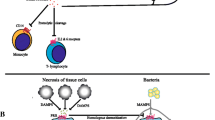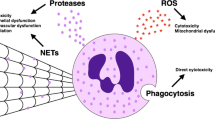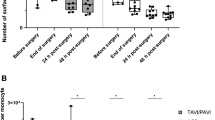Abstract.
Objective: In order to determine the effect of surgical trauma on neutrophil functions, we set up an experimental abdominal surgical model using rats and analyzed neutrophil functions. In addition, we measured tumor necrosis factor-α (TNF-α), cytokine-induced neutrophil chemoattractant/growth-regulated oncogene (CINC/GRO) and nitric oxide (NO) production.¶Materials and Methods: Male Sprague-Dawley rats, 8 weeks old and weighing 250–270 g, underwent laparotomy (4 rats for each experiment). After the operation, neutrophil chemotaxis was assayed using a modified Boyden chamber, and phagocytosis, active oxygen production and adhesion molecule expression were analyzed by flow cytometry. TNF-α and CINC/GRO levels were quantified by an immuno-dot-blot assay, and NO levels were measured by the Griess method. At the operation, NO inhibitor, NG-monomethyl-L-arginine acetate (L-NMMA, 40 mg) was intraperitoneally administered, and the effect of L-NMMA was studied.¶Results: After the surgical trauma (24–48 h), blood neutrophil counts significantly increased (p < 0.001), and neutrophil chemotaxis, phagocytosis and active oxygen production were markedly enhanced (p < 0.01). Moreover, up-regulation of Mac-1 and down-regulation of L-selectin on neutrophils were observed (p < 0.05). The levels of TNF-α, CINC/GRO and NO increased remarkably in both blood and ascites at 8–48 h after the surgical trauma (p < 0.01): TNF-α increased from 194 ± 9 (the mean ± SD, n = 4) and 183 ± 12 pg/ml (pre-operation) to 797 ± 28 and 1045 ± 137 pg/ml at 24 h in blood and ascites, respectively; CINC/GRO increased from 0.1 ± 0 and 0.1 ± 0 ng/ml (pre-operation) to 66.4 ± 4.5 and 60.3 ± 17.9 ng/ml at 8 h in blood and ascites, respectively; NO increased from 2.4 ± 1.0 and 4.2 ± 1.1 μM (pre-operation) to 11.9 ± 0.7 and 36.9 ± 2.1 μM in blood and ascites at 24 h and 48 h in blood and ascites, respectively. Interestingly, L-NMMA treatment significantly reduced the increased levels of TNF-α and CINC/GRO and altered the enhanced neutrophil functions (p < 0.05).¶Conclusion: These observations indicate that abdominal surgical trauma induces the production of NO, TNF-α and CINC/GRO, and enhances neutrophil functions such as chemotaxis, phagocytosis and active oxygen production. Furthermore, L-NMMA likely modulates the neutrophil functions and the production of TNF-α and CINC/GRO after the surgical trauma.
Similar content being viewed by others
Author information
Authors and Affiliations
Additional information
Received 1 August 1997; returned for revision 14 September 1997; accepted by M. Katori 12 November 1997
Rights and permissions
About this article
Cite this article
Shijo, H., Iwabuchi, K., Hosoda, S. et al. Evaluation of neutrophil functions after experimental abdominal surgical trauma. Inflamm. res. 47, 67–74 (1998). https://doi.org/10.1007/s000110050278
Published:
Issue Date:
DOI: https://doi.org/10.1007/s000110050278




